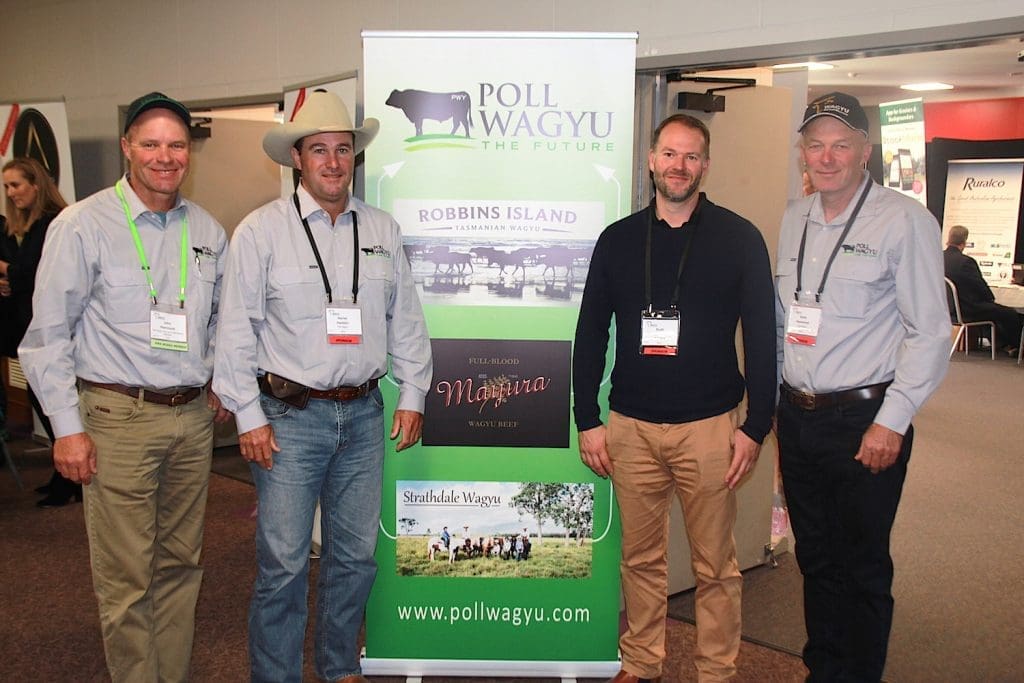
The long-term Wagyu breeders behind the Poll Wagyu breeding program: (from left to right): John Hammond, Darren Hamblin, Scott de Bruin and Keith Hammond.
WAGYU cattle are traditionally horned but a unique breeding partnership between three prominent commercial Wagyu breeders is set to give producers greater access to Polled Wagyu bulls later this year.
The “Poll Wagyu” stud has been formed by three leading commercial Wagyu breeders – the Hammond family from Robbins Island Wagyu in Tasmania, the De Bruin family from Mayura Wagyu in South Australia and the Hamblin family from Strathdale Wagyu in Queensland.
The three operations have large and long established commercial herds with leading full blood genetics. Three years ago they began pooling their genetic resources and expertise to help fill growing demand for Polled Wagyu bulls.
The three producers have been selecting Wagyu genetics carrying the poll phenotype to breed back over high-performing genetics in their herds using embryo transfer and artificial insemination programs.
70 bulls from the first drop of 190 embryo transfer program calves have been selected and will be available to the market from later this year.
50 Poll Wagyu bulls will be offered via AuctionsPlus in September, and a further 20 Poll Wagyu bulls will be offered at the 2018 Australian Wagyu Conference at Mackay next May.
The Poll Wagyu partners encountered strong interest in their program at the recent Australian Wagyu Association conference in Albury, NSW.
The attractions of polled cattle for Wagyu breeders are the same as for any breed, in that genetically polled cattle can dramatically reduce or eliminate the cost, labour, welfare and productivity issues associated with dehorning.
Genetically removing horns means cattle are safer to handle, and less likely to cause injuries to other cattle, which can also cause financial losses due to bruising of carcasses.
The partners see Northern Australian as an obvious market for polled bulls, where eliminating dehorning can deliver significant cost-savings and benefits across large herds.
However they also experienced strong interest from southern breeders at last week’s Wagyu conference in Albury.
Scott de Bruin said many southern producers were traditionally used to polled cattle, and were enthusiastic about the prospect of being able to breed from Polled Wagyu genetics.
Darren Hamblin said in the North some commercial Wagyu breeders had indicated that while they would like to breed second cross (F2) Wagyu cattle to improve marbling, they had been sticking with first cross (F1) production because the progeny were polled.
“F2 will give them better marbling, that is where the market has got to go, and now they are thinking they can put a poll bull over those F1s, and they’re all going to be polled,” Mr Hamblin explained.
While the Poll Wagyu stud will be able to start satisfying demand for polled bulls later this year, they also stress that they will not be compromising on quality just to keep up with demand.
“Go steady, we haven’t got enough,” was Mr Hamblin’s message to prospective purchasers at the conference.
“We want to be careful that we don’t get pushed into producing volume, and that we put our emphasis on producing quality. It will multiply quickly once we have the right product.”
The process of breeding up polled genetics from purebred herds means polled herds in Australia cannot be 100pc Fullbloods. The highest percentage female in the group’s polled herd right now is sitting at 98.1pc.
However, the three producers are confident that carcase data will be the factor that drives demand for these bulls, particularly from the many operations that have bred up to purebred herds.
“That is potentially an issue for some people, but I think as we get more carcase data that will be the overriding factor,” Keith Hammond said.
Mr de Bruin said the focus has been to breed polled genetics without compromising carcase characteristics.
“One of the things that has been really important for us as we make the transition from horned Wagyu is to keep that consistency of what this breed achieves,” he explained.
“The Wagyu breed is about producing highly marbled carcases.
“Now that we are breeding for the polled trait, we need to make sure that we keep that marbling trait in there as well.”
“The three herds have got excellent genetics so we have been able to bring in genetic diversity.
“We are all commercial operators, so we understand the commercial requirements of both cattle production and Wagyu beef, and we understand the quality aspects associated. We are bringing all of that knowledge into this system’
Asked how many bulls the stud could be likely to offer in future, the breeders indicated 200 bulls per year is likely to be an achievable target in the medium term.
- More information is available on the Poll Wagyu website
